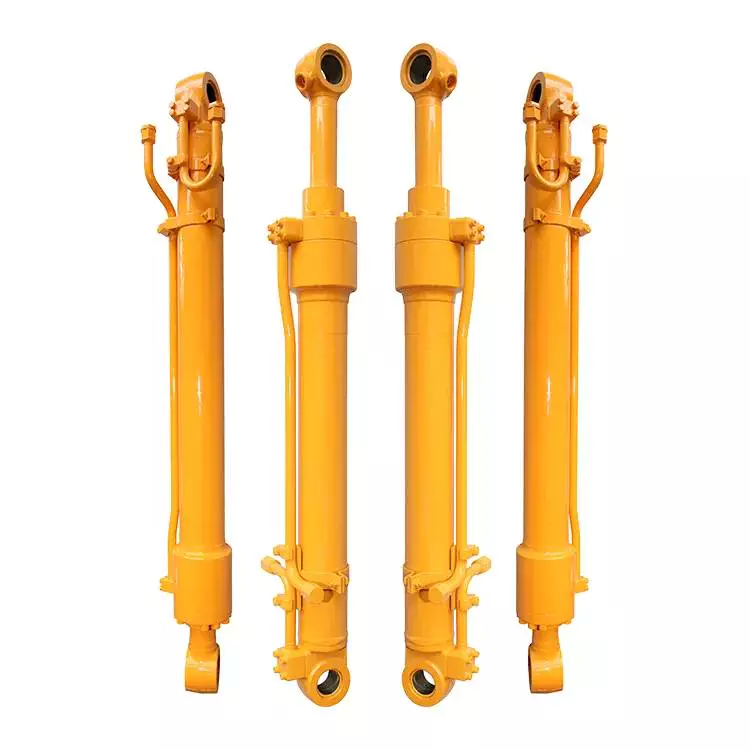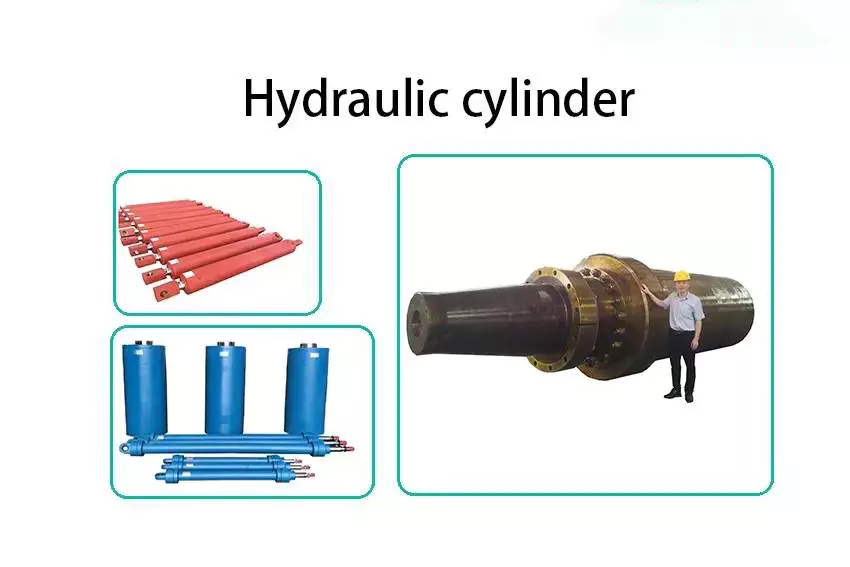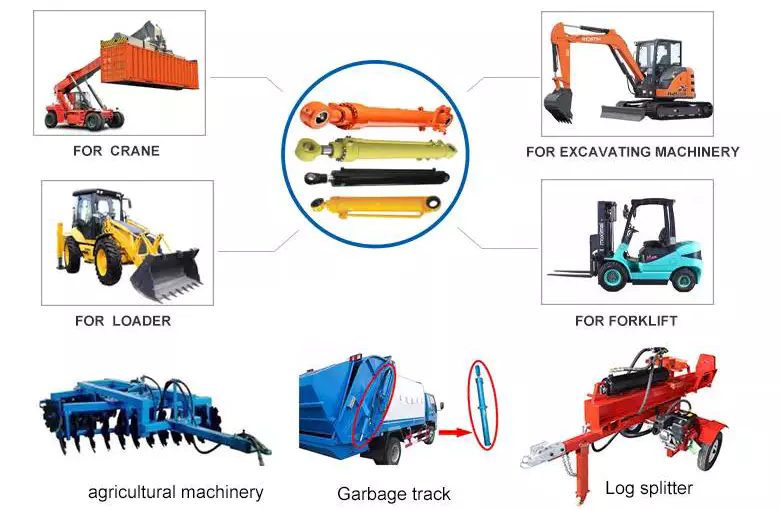Description du produit
Packaging & delivery
Packaging Details Hydraulic Cylinder Hard Chrome Plated Piston Rods,packing in wooden box.
Port ZheJiang or HangZhou
Product name: Hydraulic Cylinder Hard Chrome Plated Piston Rods
Type: Chrome Plated Rod
Material: carbon Steel, Stainless Steel
Steel Grade: CK45, ST52, 20MnV6,42CrMo4, 40Cr
D.: 40-400mm
W.T: ≥5mm
Alloy Or Not: Non-alloy
Length: Up To 12000mm According To Customer's Requirement
Place Of Origin: ZHangZhoug, China (Mainland)
Surface Treatment : Chromed, Nickeled
Matériel: CK45;ST52;20MnV6;42CrMo4;40Cr
| CHEMICAL COMPOSITION(%) | ||||||||||
| Steel Grade | C% | Mn% | Si% | S% | P% | V% | Ni% | Cr% | Mo% | Cu% |
| CK45 | 0.42-0.50 | 0.50-0.80 | 0.17-0.37 | ≤0.035 | ≤0.035 | / | ≤0.25 | ≤0.25 | / | ≤0.25 |
| ST52 | ≤0.22 | ≤1.6 | ≤0.55 | ≤0.04 | ≤0.04 | 0.02-0.15 | / | / | / | / |
| 20MnV6 | 0.17-0.24 | 1.30-1.70 | 0.10-0.50 | ≤0.035 | ≤0.035 | 0.10-0.20 | ≤0.30 | ≤0.30 | / | ≤0.30 |
| 42CrMo4 | 0.38-0.45 | 0.5-0.8 | 0.17-0.37 | ≤0.035 | ≤0.035 | 0.07-0.12 | ≤0.03 | 0.90-1.20 | 0.15-0.25 | ≤0.03 |
| 40Cr | 0.37-0.45 | 0.50-0.80 | 0.17-0.37 | ≤0.035 | ≤0.035 | / | ≤0.30 | 0.80-1.1 | / | ≤0.03 |
| MECHANICAL PROPERTIES | ||||||||||
| Matériel | Tensile Strength Rm (Mpa) |
Yield Strength Rel (Mpa) |
Elogation A% |
CHARPY | CONDITION | |||||
| CK45 | 610 | 355 | 15 | >41J | Normalized | |||||
| CK45 | 800 | 540 | 20 | >41J | Q+T | |||||
| ST52 | 500 | 355 | 22 | Normalized | ||||||
| 20MnV6 | 750 | 590 | 12 | >41J | Normalized | |||||
| 42CrMo4 | 980 | 850 | 14 | >47J | Q+T | |||||
| 40Cr | 1000 | 800 | 10 | Q+T | ||||||
| SUPPLY CONDITION | Ground and chrome plated |
| CHROME THICKNESS | 20 to 30 micron |
| SURFACE ROUGHNESS | Ra≤0.2 CHINAMFG and Rt≤2 micro |
| TOLERANCE ON DIA | ISO f7 on the diameter |
| OVALITY | Half of the tolerance ISO f7 |
| STRAGHNESS | ≤0.2MM/M |
| SURFACE HARDNEDD | 850-1150 HV(vickers 100g) |
| COHESION | No craks,breaking or detaching after thermic shock(warming up at 3200 celsius degrees and cooling in water) |
| POROSITY | Test according to ISO 1456/1458 and result yaluation according to ISO 4540 rating 8-10 |
| CORROSION RESISTANCE | Test in natural salt spray according to ASTM B117-120hours |
| Results evaluation | accordin to ISO4540 RATING7-10 |
| WELDABILITY | Good |
| PACKING | Anti rust oil to be applied on material and each rod to be packed in paper sleeve |
| CERTIFICATE | All certificate related with material heat treatment and plating is required |
| Certification: | GS, RoHS, ISO9001 |
|---|---|
| Pression: | High Pressure |
| Température de travail : | Haute température |
| Manière d'agir : | Single Acting |
| Structure: | Piston Type |
| Matériel: | Acier au carbone |
| Échantillons: |
US$ 80/Meter
1 Meter(Min.Order) | |
|---|
| Personnalisation : |
Disponible
|
|
|---|

Les vérins hydrauliques peuvent-ils être installés ultérieurement sur des équipements existants pour améliorer leur fonctionnalité ?
Yes, hydraulic cylinders can be retrofitted onto existing equipment to enhance functionality and performance. Retrofitting hydraulic cylinders onto existing machinery or equipment offers several benefits, including increased power, improved control, enhanced precision, and versatility. Here's a detailed explanation of how hydraulic cylinders can be retrofitted onto existing equipment for improved functionality:
1. Puissance accrue :
– Retrofitting hydraulic cylinders allows for the addition of hydraulic power to the existing equipment. By integrating hydraulic cylinders, the equipment can generate higher forces and handle heavier loads. This increased power enables the equipment to perform tasks that were previously challenging or impossible. For example, a retrofit hydraulic cylinder on a crane can enhance its lifting capacity and enable it to handle heavier loads more efficiently.
2. Contrôle amélioré :
– Hydraulic cylinders provide precise control over the motion and positioning of equipment. By retrofitting hydraulic cylinders, operators gain better control over the speed, force, and direction of movement. The addition of hydraulic control valves and a hydraulic power unit allows for fine-tuning of the equipment's operation. Improved control facilitates safer and more efficient operation, reducing the risk of damage and improving overall productivity.
3. Précision améliorée :
– Retrofitting hydraulic cylinders onto existing equipment can significantly improve precision and accuracy. Hydraulic systems offer precise control over movement, enabling smooth and controlled motion. This enhanced precision is beneficial in applications where precise positioning or repetitive movements are required. For instance, retrofitting hydraulic cylinders onto a robotic arm can enhance its accuracy and repeatability, making it more suitable for tasks that demand high precision.
4. Polyvalence et adaptabilité :
– Retrofitting hydraulic cylinders can increase the versatility and adaptability of existing equipment. Hydraulic systems can be easily integrated with various types of machinery, allowing for the utilization of hydraulic power across different applications. The modular nature of hydraulic components facilitates the retrofitting process, enabling the equipment to perform a broader range of tasks. This versatility is particularly advantageous in industries where equipment needs to adapt to changing operational requirements.
5. Kits de modernisation et personnalisation :
– Manufacturers often provide retrofit kits that include all the necessary components for integrating hydraulic cylinders onto existing equipment. These kits typically consist of hydraulic cylinders, mounting brackets, hoses, fittings, control valves, and other required accessories. Retrofit kits simplify the retrofitting process and ensure compatibility between the hydraulic components and the existing equipment. Additionally, manufacturers can offer customization options to tailor the retrofit solution to specific equipment and application needs.
6. Solution rentable :
– Retrofitting hydraulic cylinders onto existing equipment can be a cost-effective solution compared to purchasing new machinery. By leveraging the existing equipment's structural framework and mechanical components, the overall cost of upgrading can be reduced. Retrofitting also minimizes downtime since the equipment does not need to be completely replaced. Furthermore, the improved functionality and performance resulting from the retrofit can lead to increased productivity and cost savings in the long run.
7. Installation et expertise professionnelles :
– Retrofitting hydraulic cylinders onto existing equipment often requires professional installation and expertise. Working with experienced hydraulic system integrators or manufacturers ensures proper installation, compatibility, and optimal performance of the retrofit solution. These professionals can assess the existing equipment, recommend suitable hydraulic components, and carry out the retrofitting process efficiently. Their knowledge and expertise contribute to the successful integration of hydraulic cylinders and the overall improvement of equipment functionality.
En résumé, les vérins hydrauliques peuvent effectivement être installés ultérieurement sur des équipements existants pour en améliorer la fonctionnalité. Ce processus d'adaptation offre des avantages tels qu'une puissance accrue, un meilleur contrôle, une précision accrue, une polyvalence, une rentabilité et un accès à des kits d'adaptation et à des options de personnalisation. En adaptant les vérins hydrauliques, les équipements existants peuvent être mis à niveau pour répondre aux besoins opérationnels en constante évolution, prolonger leur durée de vie et améliorer les performances globales.

Adaptation des vérins hydrauliques aux équipements médicaux et aux applications aérospatiales
Les vérins hydrauliques peuvent être adaptés aux équipements médicaux et aux applications aérospatiales, offrant des avantages uniques dans ces secteurs. Voyons comment les vérins hydrauliques peuvent être adaptés à ces domaines spécialisés :
- Équipement médical : Les vérins hydrauliques peuvent être adaptés à diverses applications d'équipements médicaux, notamment les lits d'hôpitaux, les lève-personnes, les tables chirurgicales et les appareils de rééducation. Voici comment les vérins hydrauliques sont bénéfiques dans les équipements médicaux :
- Positionnement et réglage : les vérins hydrauliques assurent un mouvement précis et fluide, permettant un positionnement et des réglages précis de l'équipement médical. Cela est essentiel pour garantir le confort du patient, un alignement correct et une facilité d'utilisation.
- Manutention de charges : les vérins hydrauliques offrent des capacités de force élevées, permettant la manutention en toute sécurité de charges lourdes dans les équipements médicaux. Ils peuvent supporter le poids des patients, faciliter les transitions en douceur et assurer la stabilité pendant les procédures.
- Mouvement contrôlé : les vérins hydrauliques assurent un mouvement contrôlé et stable, essentiel pour les procédures médicales délicates. La possibilité de régler la vitesse, la position et la force permet des mouvements précis et contrôlés, minimisant l'inconfort du patient et garantissant un traitement précis.
- Durabilité et fiabilité : les vérins hydrauliques sont conçus pour résister à une utilisation rigoureuse et à des environnements exigeants, ce qui les rend adaptés aux applications d'équipements médicaux. Leur durabilité et leur fiabilité contribuent aux performances et à la sécurité à long terme des dispositifs médicaux.
- Systèmes de contrôle de vol : les vérins hydrauliques jouent un rôle essentiel dans les systèmes de contrôle de vol des avions, notamment les ailerons, les gouvernes de profondeur, les gouvernails et le train d'atterrissage. Ils assurent un actionnement précis et fiable, permettant aux pilotes de contrôler les mouvements de l'avion avec précision et réactivité.
- Optimisation du poids : les vérins hydrauliques peuvent être conçus à l'aide de matériaux légers, tels que des alliages d'aluminium ou des matériaux composites, pour réduire le poids total. Cette optimisation du poids est essentielle dans les applications aérospatiales pour améliorer le rendement énergétique, la capacité de charge utile et les performances des avions.
- Résistance aux chocs et aux vibrations : les environnements aérospatiaux impliquent des forces de choc et de vibration importantes. Les vérins hydrauliques peuvent être conçus pour résister à ces charges dynamiques tout en maintenant les performances et la fiabilité, garantissant un fonctionnement constant même dans des conditions extrêmes.
- Contraintes d'espace : les vérins hydrauliques peuvent être conçus pour s'adapter aux contraintes d'espace des avions ou des engins spatiaux. Leur taille compacte et leurs options de montage flexibles permettent une intégration efficace dans l'espace limité disponible.
En résumé, les vérins hydrauliques peuvent être adaptés pour être utilisés dans les équipements médicaux et les applications aérospatiales, en tirant parti de leur positionnement précis, de leurs capacités de manutention de charges, de leurs mouvements contrôlés, de leur durabilité et de leur fiabilité. Dans les équipements médicaux, les vérins hydrauliques permettent un positionnement confortable du patient, des transitions en douceur et des mouvements contrôlés pendant les procédures. Dans l'aérospatiale, les vérins hydrauliques offrent un actionnement précis, une optimisation du poids, une résistance aux chocs et aux vibrations et des solutions peu encombrantes. En adaptant les vérins hydrauliques à ces domaines spécialisés, les fabricants peuvent répondre aux exigences uniques et améliorer les performances des équipements médicaux et des systèmes aérospatiaux.

Which industries and machinery commonly use hydraulic cylinders for power transmission?
Hydraulic cylinders are widely used in various industries and machinery for power transmission due to their ability to generate high force, precise control, and reliable operation. They play a crucial role in converting hydraulic energy into mechanical force and motion. Here are the detailed industries and machinery that commonly utilize hydraulic cylinders for power transmission:
1. Construction and Heavy Equipment:
– Hydraulic cylinders are extensively used in the construction industry for tasks involving heavy lifting, pushing, and positioning. They are employed in cranes, excavators, loaders, bulldozers, and other heavy equipment to lift and move heavy loads, operate attachments, and manipulate construction materials. Hydraulic cylinders provide the necessary force and control for tasks such as lifting and lowering buckets, extending and retracting booms, and tilting blades.
2. Material Handling and Logistics:
– In material handling and logistics applications, hydraulic cylinders are vital components for the movement and manipulation of goods. They are used in forklifts, stackers, palletizers, and conveyor systems to lift, lower, and position loads with precision. Hydraulic cylinders enable the efficient transfer of heavy objects, facilitate stacking and sorting operations, and contribute to the smooth operation of material handling equipment.
3. Agriculture and Farming:
– The agricultural industry relies on hydraulic cylinders for various tasks in farming equipment. Tractors, harvesters, sprayers, and loaders utilize hydraulic cylinders to perform functions such as lifting and lowering implements, adjusting the position of attachments, and steering operations. Hydraulic cylinders enable efficient and precise control in tasks like plowing, tilling, harvesting, and baling, enhancing productivity and convenience in agricultural operations.
4. Mining and Extraction:
– Hydraulic cylinders are extensively utilized in the mining and extraction industry for their ability to handle heavy loads and operate in challenging environments. They are employed in mining equipment such as dump trucks, loaders, and excavators for tasks like ore extraction, rock breaking, and material transport. Hydraulic cylinders provide the force required for excavating, loading, and dumping operations, contributing to the efficiency and productivity of mining operations.
5. Manufacturing and Industrial Machinery:
– Hydraulic cylinders are an integral part of various manufacturing and industrial machinery. They are utilized in presses, stamping machines, injection molding machines, and metal forming equipment to apply force for shaping, bending, and pressing operations. Hydraulic cylinders enable precise control over the force and speed required for manufacturing processes, ensuring accurate and consistent results.
6. Automotive and Transportation:
– Hydraulic cylinders are employed in the automotive and transportation industry for a range of applications. They are used in vehicle lifting systems, such as car lifts and hydraulic jacks, for maintenance and repairs. Hydraulic cylinders are also utilized in bus doors, truck tailgates, and cargo handling systems to provide controlled movement and positioning. Additionally, hydraulic suspension systems in trucks, buses, and trailers use hydraulic cylinders for load leveling and stability.
7. Aerospace and Aviation:
– The aerospace and aviation industry relies on hydraulic cylinders for various applications, including aircraft landing gear, wing flaps, and flight control systems. Hydraulic cylinders provide the necessary force and precise control for extending and retracting landing gear, adjusting wing surfaces, and actuating control surfaces. They contribute to the safe and efficient operation of aircraft, ensuring reliable performance during takeoff, landing, and flight maneuvers.
8. Marine and Offshore:
– Hydraulic cylinders are utilized in marine and offshore equipment for a wide range of tasks. They are found in ship and boat steering systems, hatch covers, cranes, winches, and anchor handling equipment. Hydraulic cylinders enable precise control and powerful force transmission in maritime applications, supporting navigation, cargo handling, and offshore operations.
In summary, hydraulic cylinders are commonly used in industries such as construction, material handling, agriculture, mining, manufacturing, automotive, aerospace, marine, and more. They are integral components in machinery and equipment that require reliable power transmission, precise control, and the ability to handle heavy loads. The versatile nature of hydraulic cylinders allows them to be adapted to various applications, contributing to increased efficiency, productivity, and safety in numerous industries.


editor by CX 2023-12-01
